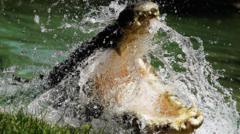As dawn breaks over Darwin Harbour, Kelly Ewin, a government ranger, balances on a floating trap designed to capture the region's formidable saltwater crocodiles. He holds a noose in hand, acutely aware of the potential danger as the reptile thrashes inside the trap. “You get pretty much zero chances with these guys,” he says, emphasizing the precarious nature of his job in Australia’s Northern Territory (NT), where about 100,000 wild saltwater crocodiles flourish—the highest concentration globally.
Once nearing extinction due to rampant hunting for their skins, saltwater crocodiles have rebounded since hunting bans were placed in 1971. Despite their protected status, the Northern Territory now faces the challenge of managing the population growth of these apex predators to ensure public safety. The dilemma intensifies as crocodiles encroach on human spaces, especially during breeding season.
Fatal crocodile encounters, while rare, stoke public fears and debates about wildlife management. In the wake of a tragic incident involving a child last year, the discourse surrounding crocodile control has reached new levels. Local officials are keenly aware that poor public sentiment could lead to rash political decisions counterproductive to conservation efforts. “The worst thing that can happen is when people turn against crocodiles,” states croc expert Prof. Grahame Webb.
Public education initiatives, such as the “Be Crocwise” program, have emerged as crucial tools in informing locals and visitors about safely navigating shared habitats. Natasha Hoffman, a ranger involved in the program, emphasizes the importance of awareness: “If you’re on the boats when you’re fishing, you need to be aware that they’re there.”
Rather than implementing mass culling—currently not an option due to conservation laws—a recent 10-year crocodile management plan allows for an increase in the quota for crocodiles killed annually from 300 to 1,200. This approach supports ongoing efforts to keep dangerous crocs away from populated areas.
In addition to the conservation and safety challenges, the booming crocodile tourism industry adds a layer of complexity. Tourists flock to Northern Territory for thrilling encounters, such as "croc jumping," while luxury brands eye crocodile skins for high-end fashion items. This creates a paradox: while fear of crocodiles grows, the industry thrives and bolsters local economies.
Partnerships between Indigenous communities and crocodile farmers are also playing a role in fostering economic opportunities connected to their cultural heritage. Traditional Owner Otto Bulmaniya Campion notes, “More partnerships are crucial for ensuring Aboriginal and Torres Strait Islander communities share in the financial benefits of the industry.” Emphasizing the significant role crocodiles have in Indigenous cultures, his goal is to see local populations become actively involved in managing their traditional custodianship.
Despite the rising number of crocodiles, a common sentiment among local experts is that the peril of swimming in crocodile-infested waters is very real, with grave consequences for the unwary. As the balance between wildlife management and public safety continues to tip, the authorities’ challenge will be to navigate the complexities of crocodile conservation in a way that respects both the predators and the communities that call their habitats home.





















